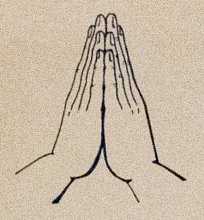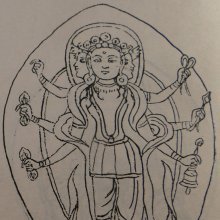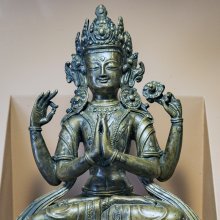Namaskaramudra, Namaskāramudrā, Namaskara-mudra: 1 definition
Introduction:
Namaskaramudra means something in Hinduism, Sanskrit. If you want to know the exact meaning, history, etymology or English translation of this term then check out the descriptions on this page. Add your comment or reference to a book if you want to contribute to this summary article.
Images (photo gallery)
(+3 more images available)
In Hinduism
Shaivism (Shaiva philosophy)
Source: Scribd: Roots of Yoga (shaivism)Namaskāramudrā (नमस्कारमुद्रा, “paying homage seal”) is the name of a mudrā (“hand-gesture”) specified in the Niśvāsatattvasaṃhitā (uttarasūtra 4.10a-23b). The Niśvāsatattvasaṃhitā is probably the earliest surviving Śaiva Tantra, the contents of which dating back to the 5th century. It consists of five books: Niśvāsamukha, Mūlasūtra, Uttarasūtra, Nayasūtra and Guhyasūtra.
Accordingly, “Put the hands together and extend all the pairs of digits. This is called the namaskāra-mudrā (‘paying homage sal’), used in venerating all gods”.

Shaiva (शैव, śaiva) or Shaivism (śaivism) represents a tradition of Hinduism worshiping Shiva as the supreme being. Closely related to Shaktism, Shaiva literature includes a range of scriptures, including Tantras, while the root of this tradition may be traced back to the ancient Vedas.
See also (Relevant definitions)
Partial matches: Mudra, Namaskara.
Full-text: Mahashankhanatha, Maharatnakirti, Vasudhara.
Relevant text
Search found 5 books and stories containing Namaskaramudra, Namaskāramudrā, Namaskara-mudra, Namaskāra-mudrā; (plurals include: Namaskaramudras, Namaskāramudrās, mudras, mudrās). You can also click to the full overview containing English textual excerpts. Below are direct links for the most relevant articles:
Jain Remains of Ancient Bengal (by Shubha Majumder)
Caubisi type of Candraprabha sculptures < [Chapter 6 - Iconographic Study of Jaina Sculptural Remains]
Pañca-tīrthika type of Candraprabha sculptures < [Chapter 6 - Iconographic Study of Jaina Sculptural Remains]
Pañca-tīrthika type of Ṛṣabhanātha sculptures < [Chapter 6 - Iconographic Study of Jaina Sculptural Remains]
The Indian Buddhist Iconography (by Benoytosh Bhattachacharyya)
108 forms of Avalokiteśvara (56): Mahāśaṅkhanātha Lokeśvara
108 forms of Avalokiteśvara (55): Mahāratnakīrti Lokeśvara
Stupas in Orissa (Study) (by Meenakshi Chauley)
Emanations of Ratnasambhava < [Chapter 5]
Sripura (Archaeological Survey) (by Bikash Chandra Pradhan)
Gandhesvara Temple < [Chapter 2 - The Architectural Panorama]
The Padma Purana (by N.A. Deshpande)
Chapter 86 - The Investiture of the Sacred Thread < [Section 6 - Uttara-Khaṇḍa (Concluding Section)]





